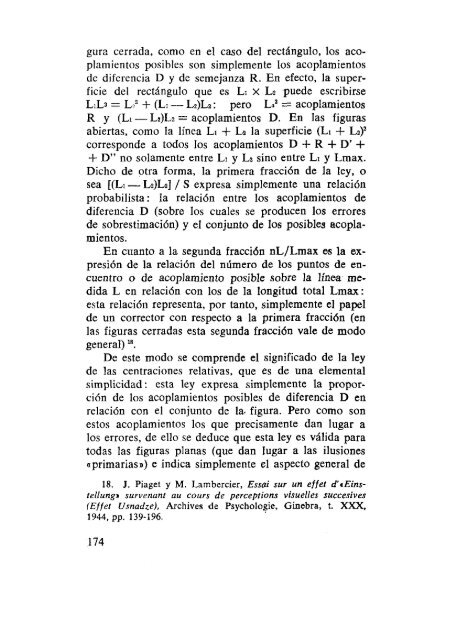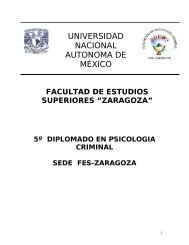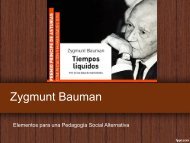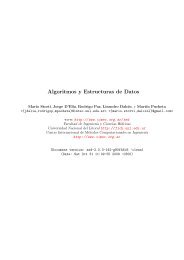SEIS ESTUDIOS DE PSICOLOGÍA Jean Piaget - Colegio de la Loza
SEIS ESTUDIOS DE PSICOLOGÍA Jean Piaget - Colegio de la Loza
SEIS ESTUDIOS DE PSICOLOGÍA Jean Piaget - Colegio de la Loza
You also want an ePaper? Increase the reach of your titles
YUMPU automatically turns print PDFs into web optimized ePapers that Google loves.
gura cerrada, como en el caso <strong>de</strong>l rectángulo, los acop<strong>la</strong>mientos<br />
posibles son simplemente los acop<strong>la</strong>mientos<br />
<strong>de</strong> diferencia D y <strong>de</strong> semejanza R. En efecto, <strong>la</strong> superficie<br />
<strong>de</strong>l rectángulo que es Li X La pue<strong>de</strong> escribirse<br />
LiLa = W + (Li — L2)La: pero L.^ = acop<strong>la</strong>mientos<br />
R y (Li — L!)L2 = acop<strong>la</strong>mientos D. En <strong>la</strong>s figuras<br />
abiertas, como <strong>la</strong> línea Li + La <strong>la</strong> superficie (Li + La)'<br />
correspon<strong>de</strong> a todos los acop<strong>la</strong>mientos D + R -f- D' -f-<br />
+ D" no so<strong>la</strong>mente entre Li y La sino entre Li y Lmax.<br />
Dicho <strong>de</strong> otra forma, <strong>la</strong> primera fracción <strong>de</strong> <strong>la</strong> ley, o<br />
sea [(Li — L2)La] / S expresa simplemente una re<strong>la</strong>ción<br />
probabilista: <strong>la</strong> re<strong>la</strong>ción entre los acop<strong>la</strong>mientos <strong>de</strong><br />
diferencia D (sobre los cuales se producen los errores<br />
<strong>de</strong> sobrestimación) y el conjunto <strong>de</strong> los posibles acop<strong>la</strong>mientos.<br />
En cuanto a <strong>la</strong> segunda fracción nL/Lmax es <strong>la</strong> expresión<br />
<strong>de</strong> <strong>la</strong> re<strong>la</strong>ción <strong>de</strong>l número <strong>de</strong> los puntos <strong>de</strong> encuentro<br />
o <strong>de</strong> acop<strong>la</strong>miento posible sobre <strong>la</strong> línea medida<br />
L en re<strong>la</strong>ción con los <strong>de</strong> <strong>la</strong> longitud total Lmax:<br />
esta re<strong>la</strong>ción representa, por tanto, simplemente el papel<br />
<strong>de</strong> un corrector con respecto a <strong>la</strong> primera fracción (en<br />
<strong>la</strong>s figuras cerradas esta segunda fracción vale <strong>de</strong> modo<br />
general) ^^<br />
De este modo se compren<strong>de</strong> el significado <strong>de</strong> <strong>la</strong> ley<br />
<strong>de</strong> <strong>la</strong>s centraciones re<strong>la</strong>tivas, que es <strong>de</strong> una elemental<br />
simplicidad: esta ley expresa simplemente <strong>la</strong> proporción<br />
<strong>de</strong> los acop<strong>la</strong>mientos posibles <strong>de</strong> diferencia D en<br />
re<strong>la</strong>ción con el conjunto <strong>de</strong> <strong>la</strong>- figura. Pero como son<br />
estos acop<strong>la</strong>mientos los que precisamente dan lugar a<br />
los errores, <strong>de</strong> ello se <strong>de</strong>duce que esta ley es válida para<br />
todas <strong>la</strong>s figuras p<strong>la</strong>nas (que dan lugar a <strong>la</strong>s ilusiones<br />
o primarias») e indica simplemente el aspecto general <strong>de</strong><br />
18. J. <strong>Piaget</strong> y M. Larr.bercier, Essai sur un effet d'tEinslellungt<br />
survenant au cours <strong>de</strong> perceptions visuelles succesives<br />
(Effet Usnadze), Archives <strong>de</strong> Psychologic, Ginebra, t. XXX,<br />
1944, pp. 139-196.<br />
174








